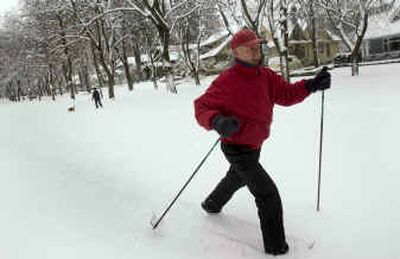Winter finally brings a good snow

The largest winter storm in more than a year blanketed the Inland Northwest with a layer of light “dry” snow on Friday.”I love it,” said Mike Johnston, manager at Coeur d’Alene Polaris. “It’s about time.”
He and other employees were using all-terrain vehicles to plow the store’s parking lot, but the job appeared to be more fun than work. Snowplow sales had been down this season, Johnston said, although business was brisk Friday.
“People were debating whether they wanted to spend $500 on a snowplow if it wasn’t going to snow,” he said. “Now they’re ready.”
Snowfall was expected to taper off or end this morning in the Spokane and Coeur d’Alene areas, but continue falling in areas to the north, especially in the mountains, forecasters said.
Brisk winds could cause some drifting near Coeur d’Alene and along the Rathdrum Prairie, forecasters warned.
Next week, the forecast calls for a possible shot of arctic cold with temperatures dropping into the single digits as early as Wednesday or Thursday nights.
Spokane and Spokane County took the brunt of the Thursday-Friday storm with accumulations up to 7 inches by midday. Spokane International Airport had 6 inches by early afternoon. The water content in that snow was .24 inches, which is considered relatively light and “dry” at a snow-to-water ratio of 25 to 1.
Four inches of snow was reported in Kootenai and Boundary counties.
More snow was forecast overnight Friday for total accumulations of 5 to 9 inches by this morning.
Jon Fox, forecaster at the National Weather Service in Spokane, said favorable atmospheric conditions contributed to the ample snowfall on Friday. He said the snowflakes formed in a slow-moving layer of saturated air between 8,000 and 14,000 feet, an ideal scenario for snow in Eastern Washington.
“We lucked out if you want the snow,” he said.
The last time so much snow fell was on Nov. 20, 2003, when 8.2 inches was measured at the airport.
Heavier snow – up to 18 inches – was forecast for the mountains of North Idaho and Northeast Washington today after a foot of snow fell at ski areas through Friday afternoon.
Residents seemed to handle the return of winter with relative calm. Spokane Police reported no collisions during the morning commute. By Friday evening, the Washington State Patrol reported 66 collisions in its five-county region of northeast Washington.
In Spokane, city and county agencies had more than 100 reports of collisions or vehicles sliding off the road. A school bus collided with a pickup truck Friday afternoon in north Spokane, and two children were treated for minor injuries.
In North Idaho, only two collisions were reported by Idaho State Police by midday Friday, with no injuries. The Kootenai County Sheriff’s Department reported nine minor crashes, but no major accidents or injuries, Capt. Ben Wolfinger said.
The National Weather Service in Spokane issued heavy-snow warnings for Spokane, Pend Oreille, Ferry, Stevens, Adams and the eastern half of Okanogan counties in Washington, and Kootenai, Shoshone, Bonner, Boundary and portions of Latah and Benewah counties in North Idaho. The east slopes of the Cascades also were under a heavy-snow warning. The warnings were to be in effect through 10 a.m. today in the Spokane and Coeur d’Alene areas, and later into the day in areas farther north.
A snow advisory was issued for the Palouse region while a hazardous weather outlook was in effect for the southern Columbia Basin.
“Too bad we didn’t get this last month,” said Bob Bonner, a meteorology technician at the Weather Service bureau.
Spokane deployed a force of 30 snowplows, sanders and de-icing trucks on Friday. Some staffers worked overtime and others were pulled from jobs on lighting and sign crews to help deal with Friday’s storm, said Mayor Jim West.
Under city policy, if accumulations of snow reach 4 inches, residential streets are expected to be plowed. However, crews will concentrate on keeping arterials, hills and bus routes cleared before moving into the neighborhoods. It takes about 72 hours for a citywide plowing effort.
Updated plowing information is available on the city’s 24-hour Snow Removal Hotline at 456-2666.
In a press release, city spokeswoman Marlene Feist said that to avoid accidents, police are asking motorists to slow down, allow for extra time to reach their destinations and provide for greater following distance. Property owners are responsible for clearing driveways and sidewalks of snow and ice, but the snow should not be tossed or blown onto roadways or alleys. Help neighbors who might struggle with this task, Feist said.
Coeur d’Alene’s plow crews were keeping arterials clear, but street Superintendent Jon Ingalls said he didn’t think the entire city would be completely plowed by the end of the weekend. The snowstorm that began Thursday was dubbed “Storm Bambi” by Coeur d’Alene street workers, who this winter will name all storms after Disney characters.
As snow continued to fall on freshly plowed streets Friday, and with more snow in the forecast, Ingalls said his crews were doing all they could to clear the streets. The department’s goal is to make a sweep through the entire city within 42 hours, but Ingalls said that’s possible only after snow stops falling.
“In this case, we’re going to be 18 hours into this plowing event and we’re likely to get hammered again and start it all over,” Ingalls said. “Folks are going to have to be patient.”
The Natural Resources Conservation Service on Friday reported the water supply outlook in Idaho remains marginal for this time of year. Good precipitation in October was followed by well-below-average precipitation in November while December’s precipitation was near average statewide.
The snowpack in most of Idaho is below the Jan. 1 average and shallower than last year at this time. Several major basins, including the Clearwater, Salmon, Payette, Snake above Palisades and Owyhee, are running 60 to 80 percent of average, the NRCS said.